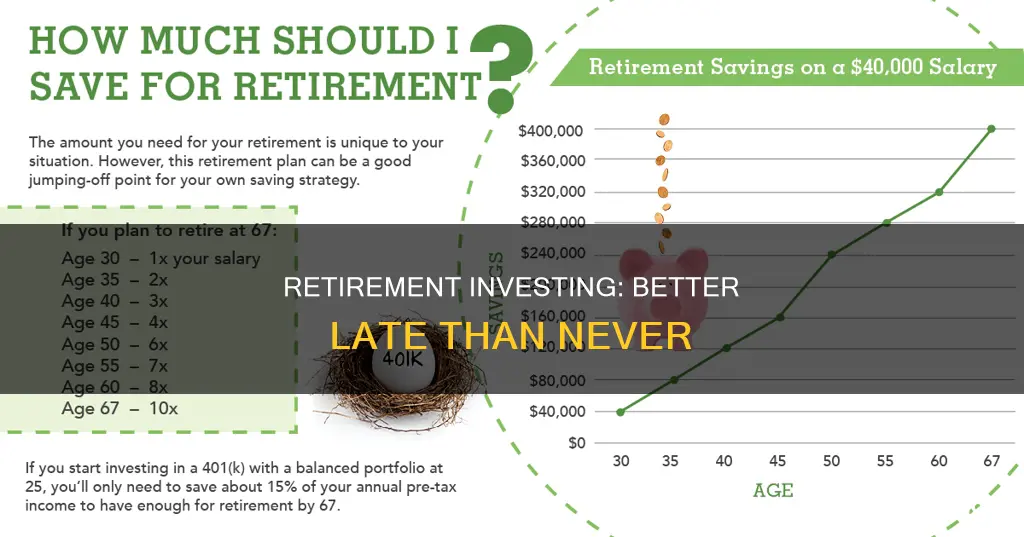
It is never too late to start investing for retirement, but the older you get, the more constraints you will face. Many people have more time than they think – starting at age 35 still gives you over 30 years to save. Even if you are in your 40s or 50s, it is not impossible to start saving for retirement. It is important to be realistic about your options, but there are some moves you can make that can have a big impact.
| Characteristics | Values |
|---|---|
| Is it too late to invest for retirement? | It is never too late to start saving for retirement. However, the older you get, the more constraints you will face. |
| How much time do you have? | Even starting at age 35 means you can have more than 30 years to save. |
| What are the best options for investing? | 401(k)s and traditional individual retirement accounts (IRAs) are the leading tax-deferred vehicles. |
| What are the contribution limits for 401(k)s? | For 2023, the limit is $22,500, and for 2024, it is $23,000. Individuals 50 or older can contribute an additional $7,500. |
| What are the contribution limits for IRAs? | For 2023, the limit is $6,500, and for 2024, it is $7,000. Individuals 50 or older can contribute an additional $1,000. |
| What are some other investment options? | Roth IRAs, tax-advantaged products like municipal bonds, annuities, and real estate. |
| What is the benefit of starting early? | Compounding effects of investing in tax-sheltered retirement vehicles. |
| What should you consider when planning for retirement? | Estimate your retirement expenses and savings options, such as employer-sponsored plans or IRAs. |
| What is the recommended savings rate? | It is recommended to save between 15% to 30% of your income for retirement. |
What You'll Learn

It's never too late to start saving for retirement
Retirement planning can be challenging, especially if you get a late start. The longer you wait to begin saving, the more overwhelming the process can seem. However, it is never too late to start saving for retirement. Even starting at age 35 means you can have more than 30 years to save and benefit from the compounding effects of investing in tax-sheltered retirement vehicles.
If you are starting later, it is important to be realistic about your options. You may need to work longer, be more aggressive with your savings, or seek additional sources of income. Here are some steps to consider:
Get Financially Fit
It is important to have a clear picture of your finances. This includes your income, expenses, debt, and spending habits. Creating a budget and reducing unnecessary spending will help you determine how much you can invest each month. It is also crucial to reduce debt, especially high-interest debt, to free up more money for retirement savings.
Do the Math and Make a Plan
Once you have a clear understanding of your finances, you can determine how much you can save and invest. It is recommended to invest 20% of your income each month if possible. Take advantage of employer-sponsored plans such as 401(k)s or IRAs, which may offer tax benefits and employer-matching contributions.
Start Investing
Consider working with a financial advisor to navigate the complexities of different investment accounts and make the best choices for your situation. They can help you maximize your savings and investments to meet your retirement goals.
Eliminate Debt
Eliminating debt, especially high-interest debt, is crucial to improving your financial position. The "snowball method" is a popular strategy, focusing on paying off small debts first and gradually tackling bigger ones. This approach helps build momentum and confidence in eliminating debt.
Create a Budget and Stick to It
Creating a detailed budget that identifies your sources of income, expenses, and historical spending patterns is essential. This allows you to optimize your savings and cut back on unnecessary spending. It is recommended to save anywhere from 15% to 30% of your income for retirement, depending on your current savings.
While it may seem daunting to start saving for retirement later in life, it is never too late to take control of your financial future. With careful planning, hard work, and persistence, you can build a comfortable retirement nest egg.
Retirement Reinvented: Navigating Post-Retirement Investment Strategies
You may want to see also

Estimate how much you'll need
Estimating how much you will need to retire comfortably is a complex task that will depend on a variety of factors. Here are some guidelines to help you make an estimate.
Firstly, you need to consider the kind of lifestyle you expect to lead in retirement. Will you travel, eat out, or pursue hobbies that require financial investment? These factors will give you an idea of the income you will need in the future. As a general rule, it is recommended that you will need 70% of your pre-retirement income to live comfortably. However, if you plan to pursue expensive projects, you may need 100% or more of your current income.
A common rule suggests that you save 10-15% of your pre-tax income per year. For example, if you make $50,000 per year, you should put away $5,000-$7,500. By saving 10% starting at age 25, you could potentially have a nest egg of $1 million by the time you retire.
Another rule of thumb suggests that an income of 70-80% of your pre-retirement income will maintain your standard of living after retirement. For example, if you made $100,000 per year during your working life, you could maintain your standard of living with $70,000-$80,000 per year of income after retirement.
You can also use what is known as the 4% rule. This means that you take the amount you estimate you will need per year in retirement and divide it by 4% to determine the nest egg you will require. For example, if you estimate you will need $100,000 per year, you will need a nest egg of $2.5 million.
Some experts claim that savings of 15-25 times your current annual income are enough to last throughout retirement.
Other factors to consider
It is important to consider the impact of inflation on your retirement savings. Inflation decreases the purchasing power of money over time. In the US, the average inflation rate over the past 30 years has been around 2.6% per year. Inflation can cause people to underestimate how much they need to save for retirement.
You should also consider other sources of retirement income besides your savings, such as Social Security, pension plans, and investments. These can include mutual funds, index funds, individual stocks, real estate, and bonds.
Who Invests and Why?
You may want to see also

Look at your savings options
There are several savings options to consider when investing for retirement. Here are some of the most popular choices:
- 401(k) plans: These are the leading tax-deferred vehicles for retirement savings. They allow you to deduct your contributions annually and defer tax payments until retirement, typically at a lower rate than during your higher-earning years. Many employers match their employees' contributions, which provides an added benefit. The contribution limits for 401(k) plans are $23,000 for 2024, with a catch-up contribution of $7,500 for individuals aged 50 or older.
- Traditional Individual Retirement Accounts (IRAs): IRAs offer similar advantages to 401(k) plans, including tax deductions on contributions and tax-deferral on withdrawals until retirement. The IRA contribution limit for 2024 is $7,000, with a catch-up contribution of $1,000.
- Roth IRAs: Contributions to Roth IRAs are made with after-tax dollars, but withdrawals in retirement, including investment earnings, are tax-free. Additionally, Roth IRAs offer flexibility as contributions can be withdrawn tax- and penalty-free at any time. The contribution limits for Roth IRAs are the same as for traditional IRAs.
- Spousal IRAs: This is a strategy that allows married couples to maximise their retirement savings using IRAs. If one spouse is not working or earns significantly less, they can open a spousal IRA and make contributions based on their household income.
- Annuities: Annuities are insurance contracts that can supplement your retirement savings. Fixed annuities, in particular, offer predictable benefits, tax-deferred growth, and sometimes a death benefit. Annuities are not subject to IRS contribution limits.
- Health Savings Accounts (HSAs): HSAs are typically used for healthcare expenses, but they can also function as supplemental retirement accounts. Contributions are made on a pre-tax basis, growth is tax-free, and withdrawals after age 65 can be used for any purpose without penalty, although taxes may apply.
- 529 Education Savings Plans: While originally intended for education expenses, these plans can now be used to fund a Roth IRA, providing additional flexibility for retirement savings.
It's important to note that the availability of certain retirement savings options may depend on your employment status and the plans offered by your employer. If you are self-employed or running a small business, you may also have access to additional options such as SEP IRAs, SIMPLE IRAs, and solo 401(k) plans.
Should I Liquidate My Investments to Pay Off Debt?
You may want to see also

Take advantage of catch-up contributions
Catch-up contributions are a type of retirement savings contribution that allows people aged 50 or older to make additional deposits into their tax-advantaged retirement savings accounts. Introduced by President George W. Bush in 2001, they allow employees to make extra contributions to their 401(k) plans, 403(b) plans, government 457(b) plans, traditional or Roth IRAs, SARSEPs, SIMPLE-401(k)s, or SIMPLE-IRAs.
The catch-up contribution limit for 401(k) plans in 2024 is $7,500, the same as it was in 2023. This means that employees aged 50 and above can contribute a maximum of $30,500 in 2024, as the standard maximum contribution is $23,000.
For IRAs, the catch-up contribution limit is $1,000 for 2023, on top of the annual contribution limit of $6,500. In 2024, the contribution limit rises to $7,000, with the same $1,000 catch-up contribution.
The Economic Growth and Tax Relief Reconciliation Act of 2001 (EGTRRA) created the catch-up contribution provision, and the Pension Protection Act of 2006 made these provisions permanent.
The IRS allows catch-up contributions for people who also participated in 403(b) and Thrift Savings Plans. For 2024, the catch-up contribution amount for these plans is $7,500.
For those who do not have an employee-sponsored plan, it is possible to contribute to a traditional IRA or Roth IRA. Other options include the SIMPLE IRA and Simplified Employee Pension (SEP).
Catch-up contributions are a great opportunity for anyone who wants to boost their retirement savings. They can help make up for the years when individuals didn't save enough and allow for more time to grow savings and take advantage of compounding interest. Additionally, they can provide tax benefits, as they decrease taxable income and, in the case of Roth IRAs, allow for tax-free withdrawals in retirement.
Invest in AMC: What to Know
You may want to see also

Hire a financial advisor
It's never too late to start saving for retirement. Even if you're close to retirement, a financial advisor can help you manage your income and investments and avoid unnecessary taxes.
Step 1: Identify your financial needs
First, reflect on what you want from your relationship with a financial advisor. They can provide a wide range of services, so it's good to know what you need help with before you begin your search. Some advisors may specialize in particular areas of finance, such as debt management or investment advice, while others may provide holistic help. Ask yourself the following questions:
- Do you need help with budgeting?
- Do you want help with investing?
- Would you like to create a financial plan?
- Do you have savings goals you need help reaching?
- Do you need to get your estate plan in order or create a trust?
- Do you need tax advice?
- Are you interested in holistic financial management?
Step 2: Understand the types of financial advisors
Financial advisors go by many names, including investment advisors, brokers, certified financial planners, financial coaches, and portfolio managers. Some of the most common titles advisors use aren't tied to specific credentials, so don't assume that someone who uses an official-sounding title has the necessary training or credentials.
Some financial advisors have a fiduciary duty to their clients, meaning they are obligated to act in their client's best interest. Working with a licensed, registered fiduciary—preferably one who is fee-only—ensures that the advisor is paid directly by you and not through commissions for selling certain investment or insurance products.
Step 3: Review the range of options for financial advisors
Financial advisors are available in many places, not just your local advisory office or bank. There are online financial advisors, robo-advisors, and traditional financial advisors. The option that's right for you will depend on your personal preferences, the services you need, and your budget.
Step 4: Consider how much you can afford to pay an advisor
Financial advisors have a reputation for being costly, but there is an option for every budget. Robo-advisors, for example, can cost as little as 0.25% of your account balance per year, while traditional in-person advisors typically cost around 1%.
Step 5: Vet the financial advisor's background
No matter what title, designation, certification, or license an advisor claims to have, it's up to you to vet their credentials and experience. Always verify any credentials they claim to have and check for any disciplinary problems such as fraud. You can research an advisor's background by looking up their Form ADV and reviewing their employment record on FINRA's BrokerCheck website.
Step 6: Hire the financial advisor
If you're happy with a particular financial advisor's background and are confident that they're a good match for your financial situation, you can start working with them. The hiring process for financial advisors will vary, but here is a general outline of the steps:
- A consultation with the advisor to discuss your financial situation.
- The advisor provides you with an engagement letter outlining their ethical principles and any potential conflicts of interest.
- The advisor provides you with legal documents to sign, such as a Form ADV and/or a Form CRS.
- The advisor begins gathering information on your financial situation and starts managing your finances.
Invest in These 3 Things Now
You may want to see also







